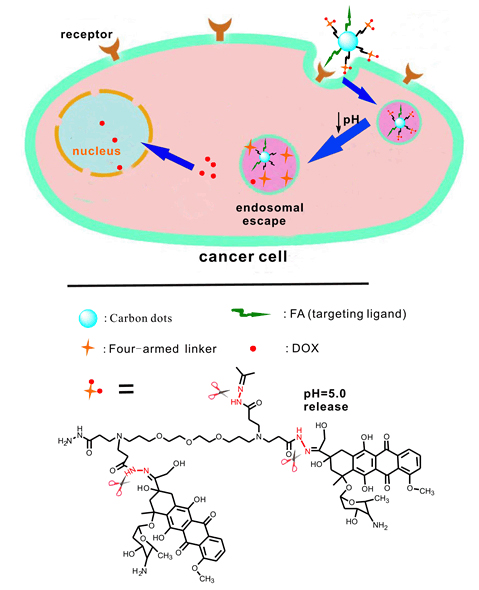

Preparation of a Multifunctional Nano-carrier System Based on Carbon Dots with pH-Triggered Drug Release
Received date: 2015-12-15
Online published: 2016-02-23
Supported by
Project supported by the NSFC (Nos. 21474031, 21174040, 21025415), China Postdoctoral Science Foundation (No. 2015M572305) and the National Key Basic Research Program of China (Project No. 2013CB834702).
A folated-functionalized nano-carrier system based on carbon dots was successfully synthesized for cancer cell-targeted drug delivery. In this report, using microwave-assisted assay the fluorescent CDots could be obtained via microwave-assisted pyrolysis of glycerol in the presence of 4,7,10-trioxa-1,13-tridecanediamine. The particle size of the CDots was confirmed by AFM and HR-TEM. The finding showed that the average diameter of CDots is about 4 nm. Incorporating (via a cleavable bond) an anticancer drug, which was Doxorubicin (DOX) in this study, and a targeting ligand (folic acid) onto carbon dot produces a more specific anticancer prodrug DOX-CDots-FA. The structure of the DOX-CDots-FA was characterized by 1H NMR and UV-vis analysis. The loading content of DOX was determined by UV-vis analysis to be 13.5 wt%, and the content of the targeting ligand FA was calculated as 3.13 wt% based on 1H NMR measurement. Particle size parameter of DOX-CDots-FA was determined by HR-TEM. The results showed that the average diameter of DOX-CDots-FA is about 6 nm. In addition, DOX-CDots-FA showed pH-dependent release, that is, the drug releases faster in pH=5.2 buffer solution than in pH=7.4 one. The cytotoxicity of DOX-CDots-FA, DOX-CDots nanoparticles and free DOX were evaluated and compared using HeLa and L929 cell lines. For the FR-positive HeLa cells, DOX-CDots-FA nanoparticles exhibit superior cytotoxicity as compared to DOX-CDots nanoparticles. These results showed that the FA moieties in DOX-CDots-FA nanoparticles play an important role in enhancing the cytotoxic effect as they increase the binding to FR-expressing cells. This high affinity binding subsequently increases their intracellular uptake as a result of receptor-mediated endocytosis. The FA molecules present on the surface of the nanoparticle prodrug do not have a remarkable effect on cellular uptake and/or cytotoxicity for FR-negative L929 cell lines. The confocal microscope studies revealed that FA-conjugated prodrug DOX-CDots-FA exhibited higher cellular uptake than FA-free nanosystem DOX-CDots which also led to higher cytotoxicity. Thus, multifunctional nano-carrier system could be a promising nanosize anticancer drug carrier with excellent targeting property.

Key words: targeted; fluorescence; prodrug; carbon dots; controlled drug releasing
Du Fangkai , Xu Jiangsheng , Zeng Fang , Wu Shuizhu . Preparation of a Multifunctional Nano-carrier System Based on Carbon Dots with pH-Triggered Drug Release[J]. Acta Chimica Sinica, 2016 , 74(3) : 241 -250 . DOI: 10.6023/A15120780
[1] Finkel, T.; Serrano, M.; Blasco, M. A. Nature 2007, 448, 767.
[2] Davis, M. E.; Chen, Z.; Shin, D. M. Nat. Rev. Drug Discovery 2008, 7, 771.
[3] Pan, D. K.; Zhang, H. Acta Chim. Sinica 2011, 69, 1545. (盘登科, 张慧, 化学学报, 2011, 69, 1545.)
[4] Pecot, C. V.; Calin, G. A.; Coleman, R. L.; Lopez-Berestein, G.; Sood, A. K. Nat. Rev. Cancer 2011, 11, 59.
[5] Modi, S.; Swetha, M. G.; Goswami, D.; Gupta, G. D.; Mayor, S.; Krishnan, Y. Nat. Nanotechnol. 2009, 4, 325.
[6] Wu, Y. L.; Chen, W.; Meng, F. H.; Wang, Z. J.; Cheng, R.; Deng, C.; Liu, H. Y.; Zhong, Z. Y. J. Controlled Release 2012, 164, 338.
[7] Kaminskas, L. M.; McLeod, V. M.; Kelly, B. D.; Cullinane, C.; Sberna, G.; Williamson, M.; Boyd, B. J.; Owen, D. J.; Porter, C. J. Mol. Pharm. 2012, 9, 422.
[8] Xiao, Y.; Hong, H.; Javadi, A.; Engle, J. W.; Xu, W.; Yang, Y.; Zhang, Y.; Barnhart, T. E.; Cai, W.; Gong, S. Biomaterials 2012, 33, 3071.
[9] Liu, C. Y.; Hu, J. H.; Yang, D.; Yang, W. L. Acta Chim. Sinica 2009, 67, 843. (刘聪颖, 胡建华, 杨东, 杨武利, 化学学报, 2009, 67, 843.)
[10] Liu, C. J.; Zhang, P.; Tian, F.; Li, W. C.; Li, F.; Liu, W. G. J. Mater. Chem. 2011, 21, 13163.
[11] Baker, S. N.; Baker, G. A. Angew. Chem., Int. Ed.2010, 49, 6726.
[12] Yang, F.; Wang, L. L.; Guo, Z. H. Acta Chim. Sinica 2012, 70, 1283. (杨帆, 王伶俐, 郭志慧, 化学学报, 2012, 70, 1283.)
[13] Wang, F.; Xie, Z.; Zhang, H.; Liu, C. Y.; Zhang, Y. G. Adv. Funct. Mater. 2011, 21, 1027.
[14] Liu, T. T.; Peng, C.; Ma, Y. C.; Ouyang, J. Acta Chim. Sinica 2013, 71, 962. (刘亭廷, 彭程, 马云川, 欧阳津, 化学学报, 2013, 71, 962.)
[15] Yang, Y. H.; Cui, J. H.; Zheng, M. T.; Hu, C. F.; Tan, S. Z.; Xiao, Y.; Yang, Q.; Liu, Y. L. Chem. Commun. 2012, 48, 380.
[16] Li, T. F.; Li, Y. W.; Xiao, L.; Yu, H. T.; Fan, L. Z. Acta Chim. Sinica 2014, 72, 227. (李腾飞, 李昳玮, 肖璐, 余洪涛, 范楼珍, 化学学报, 2014, 72, 227.)
[17] Tang, J.; Kong, B.; Wu, H.; Xu, M.; Wang, Y. C.; Wang, Y. L.; Zhao, D. Y.; Zheng, G. F. Adv. Mater. 2013, 25, 6569.
[18] Choi, Y.; Kim, S.; Choi, M. H.; Ryoo, S. R.; Park, J.; Min, D. H.; Kim, B. S. Adv. Funct. Mater. 2014, 24, 5781.
[19] Zhou, L.; Li, Z. H.; Liu, Z.; Ren, J. S.; Qu, X. G. Langmuir 2013, 29, 6396.
[20] Pandey, S.; Thakur, M.; Mewada, A.; Anjarlekar, D.; Mishra, N.; Sharon, M. J. Mater. Chem. B 2013, 1, 4972.
[21] Fan, J. Q.; Fang, G.; Zeng, F.; Wang, X. D.; Wu, S. Z. Small 2013, 9, 613.
[22] Peng, H.; Travas, S. J. Chem. Mater. 2009, 21, 5563.
[23] Allen, H. M.; Cullis, P. R. Adv. Drug Delivery Rev. 2013, 65, 36.
[24] Zhang, P.; Li, W. C.; Zhai, X. Y.; Liu, C. J.; Dai, L. M.; Liu, W. G. Chem. Commun. 2012, 48, 10431.
/
| 〈 |
|
〉 |